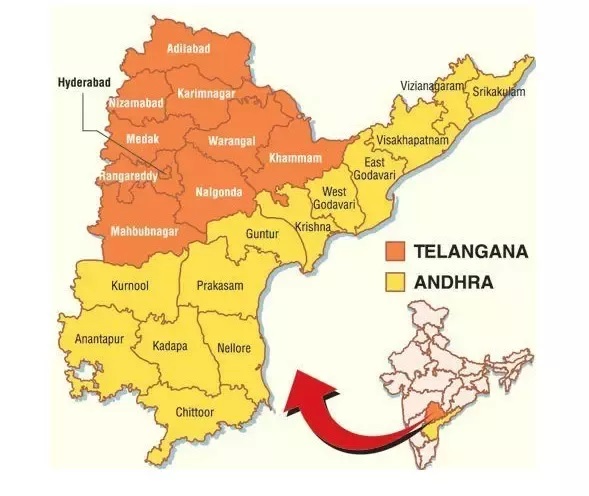Focus: GS-II Governance, Prelims
Why in news?
The Prime Minister has greeted the people of Telangana, on Statehood Day.
In February 2014, Andhra Pradesh Reorganisation Act, 2014 bill was passed by the Parliament of India for the formation of Telangana state comprising ten districts from north-western Andhra Pradesh.
The state of Telangana was officially formed on 2 June 2014.
Telangana region after Independence
- When India became independent from the British Empire in 1947, the Present region of Telangana was a part of the Hyderabad Princely State.
- The Nizam of Hyderabad did not want to merge with the Indian Union and wanted to remain independent.
- The Government of India annexed Hyderabad State on 17 September 1948 after a military operation called Operation Polo – The Nizam’s army surrendered and India then incorporated the state of Hyderabad and ended the rule of the Nizams.
- In 1956 during the reorganisation of the Indian States based along linguistic lines, the state of Hyderabad was split up among Andhra Pradesh and Bombay state (later divided into states of Maharashtra and Gujarat in 1960 with the original portions of Hyderabad becoming part of the state of Maharashtra) and Karnataka.
History of Formation of Telangana
- The seeds of Telangana struggle were sown in 1955 when the recommendation of the States Reorganisation Commission to retain Hyderabad as a separate State went unheeded.
- Telangana leaders accused the people of Andhra of “colonising the region” by grabbing their jobs and land, and the government of not investing in the region’s infrastructure.
- On November 1, 1956, Telangana merged with the State of Andhra, carved out of erstwhile Madras, to form Andhra Pradesh, a united-state for the Telugu-speaking populace.
- The State witnessed a violent ‘separate Telangana’ agitation in 1969 and a ‘separate Andhra’ agitation in 1972.
- Many believe it was the creation of Chhattisgarh, Jharkhand and Uttaranchal (now Uttarakhand) states that spurred the demand for Telangana.
Karimnagar — the hotbed of the movement
- During the first phase of the movement in 1969, Karimnagar district emerged as the centrestage for the intensification of agitations.
- Karimnagar was the host for the intensification of Telangana statehood movement in 2009, when the TRS president had decided to launch a fast-unto-death, demanding the Telangana State.
- The movement had spread like a wildfire after the arrest of K. Chandrasekara Rao in Karimnagar who was on his way to begin fast-unto-death, and several youth had committed suicide for the cause of Telangana.
- Following the continuation of his fast-unto-death while in a hospital, the Union government had announced the formation of separate Telangana State on December 9, 2009.
Sri Krishna Committee report
- On February 3, 2010, a panel headed by Justice (Retd.) B.N. Srikrishna was formed to “bring about a permanent solution” to the statehood demand.
- In December 2013, the Union Cabinet approved a Bill for the creation of Telangana State with 10 districts, paving the way for the bifurcation of Andhra Pradesh.

Features of A.P. Reorganisation Bill
- The Bill envisages Hyderabad as the common capital. The Andhra Pradesh Governor will be Governor for both successor States of Andhra Pradesh and Telangana.
- The Centre will set up an apex council for the supervision of Krishna and Godavari rivers on water sharing.
- The High Court at Hyderabad will be common for both States till a separate High Court is set up for residuary Andhra Pradesh.




